My sisters decided to start drinking tea in an attempt to stop drinking soda pop. We realized there were different types and flavors as we shopped for one that would be satisfying. Experimenting with something new doesn't always turn out so great, but finding out the differences and importance of this healthy alternative became a fun research project.
Teas differ in taste and health benefits, but they all come from the same plant: Camellia sinensis. Purists only consider the leaves of Camellia sinensis as "real" tea, and the varieties are green, black, white and oolong.
Tisane is the proper term for herbal teas. Teas that have leaves from Camellia sinensis, spices and herbs are blends. Here are a few facts about the different types of "real" teas.
• Black tea is fully fermented to allow the flavors and aromas to become richer. The tea is known for its strong flavor. It has more caffeine content that the other teas, but only about 20 percent of the same amount of coffee. Types of black tea include Darjeeling, Ceylon and Keemun. Popular blends of black tea include Earl Grey and English Breakfast.
• Green tea is dried for storage purposes instead of undergoing a fermentation process. It contains the second highest amount of caffeine. Green teas have different types: The differences in taste are due to factors such as the growing location, its climate and how it was cultivated, according to greenteas.com. It is grown mainly in India, China and Japan. Some of the most popular types are matcha, a finely ground powder; sencha, sun-dried tea leaves; and gyokuro, shade-grown dried tea leaves.
• Amber-colored Oolong tea ferments longer than green tea but not as long as black tea. The caffeine content varies upon brewing methods and other factors, but it generally has less caffeine than green or black tea. Most oolong teas come from China or Taiwan. Bai Hao Oolong or Eastern Beauty has a slight peach and honey flavor due to tiny insects that gnaw at the plant as it grows. Wuyi Oolong has a deep mineral taste and is heavily roasted for an expresso-like flavor.
• White tea leaves are picked from newer buds that are not fermented. Minimal processing creates a different taste from that of the green tea. The tea also retains more nutrients and has a slightly sweet, delicate taste. It usually costs more than the other teas. White peony, silver needle and white cloud are white tea varieties.
Source: http://www.webmd.com/diet/features/tea-types-and-their-health-benefits, http://www.the-tea-site.com, http://coffeetea.about.com, http://www.dr.weil.com



Comments
Use the comment form below to begin a discussion about this content.
comments powered by Disqus